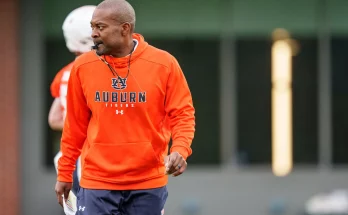NIL Bombshell Rocks Clemson Football: Explosive 5-Star Recruit’s Deal Could Cost Millions and Ignite Nationwide Fan Backlash
The college football world is no stranger to high-stakes drama, but the latest development surrounding Clemson University has sent shockwaves through fans, analysts, and the NCAA alike. In an era where Name, Image, and Likeness (NIL) deals are rapidly reshaping the landscape of college athletics, a bombshell has dropped involving a highly-touted 5-star recruit and a potentially explosive NIL agreement that could cost Clemson millions and provoke a furious reaction from fans nationwide.
At the heart of this storm is the revelation of an enormous NIL contract involving one of Clemson’s top incoming recruits. This young athlete, long heralded as a game-changing talent destined to carry the Tigers’ program into the next chapter, has reportedly signed a deal worth far more than what was initially anticipated by the public or Clemson insiders. While NIL deals have become a common way for players to monetize their collegiate fame, the sheer magnitude and structure of this particular contract have sparked intense scrutiny and debate.
The explosive nature of the deal centers on its financial size and the potential implications for Clemson’s recruiting strategy and financial health. Reports indicate that the agreement could be valued in the multimillions, a figure that dwarfs typical NIL contracts in college football and sets a new precedent for what elite recruits might command. This development not only underscores the escalating arms race in college recruiting fueled by NIL opportunities but also raises questions about fairness, regulatory oversight, and the long-term sustainability of such massive financial commitments.
Fans across Clemson’s loyal base are sharply divided. On one hand, there is excitement and pride in securing a player of such remarkable talent who is willing to join the Tigers under such lucrative terms. On the other hand, many are concerned about the potential consequences—both financial and ethical—of this deal. The immense payout has some questioning whether the university and its athletic department have stretched their resources too thin or compromised traditional values for immediate competitive advantage.
Critics argue that this NIL bombshell could exacerbate the already widening gap between blue-blood programs and smaller schools, amplifying inequalities in college sports. If Clemson is willing and able to offer such unprecedented financial incentives, it may pressure other programs to follow suit or risk losing elite talent. This could trigger a costly bidding war that ultimately prioritizes money over the student-athlete experience or academic integrity.
Beyond the financial and competitive concerns, there is also a growing fan fury directed at the perceived commercialization of college sports. Longtime supporters of Clemson’s football legacy worry that these massive NIL deals undermine the spirit of amateurism and team loyalty that has defined college football for decades. Social media platforms are buzzing with heated debates, with some fans calling for transparency and stricter regulation, while others defend the recruit’s right to capitalize on their market value in an evolving sports landscape.
The recruit at the center of this controversy remains somewhat shielded from public view, focusing instead on preparation for their collegiate debut. Nonetheless, their NIL agreement has placed them under an intense spotlight, with expectations not only on the field but as a symbol of the new era of college athletics. The pressure to perform is now compounded by the weight of financial scrutiny and the hopes of a fan base grappling with change.
Clemson’s administration and athletic department have responded cautiously but firmly. Officials acknowledge the legitimacy and importance of NIL deals in today’s environment but emphasize their commitment to compliance with NCAA regulations and institutional values. They also stress that while the contract is substantial, it reflects a competitive marketplace where top recruits have unparalleled leverage and options.
The NCAA itself finds itself in a challenging position as well. The governing body has historically sought to maintain a balance between amateurism and fair competition, but the rapid rise of NIL has complicated enforcement and policy-making. High-profile deals like this one at Clemson spotlight the difficulties in setting consistent standards and the growing calls for reform or new frameworks to manage NIL money transparently and equitably.
This unfolding NIL saga at Clemson also casts a wider light on the future trajectory of college football. As recruits gain increasing control over their personal brands and earning potential, traditional recruiting methods and program-building strategies may need to evolve significantly. Teams may prioritize not just athletic fit and academic alignment but also marketability and endorsement potential. This shift could alter the competitive landscape, player development approaches, and even fan engagement.
Moreover, the deal’s size hints at a new level of sophistication in how NIL contracts are negotiated and structured. It suggests that marketing firms, agents, and legal advisors are playing a larger role than ever before in guiding young athletes through complex financial arrangements. This professionalization of NIL deals, while beneficial for the players, adds layers of complexity for colleges striving to manage compliance and preserve their reputations.
For Clemson fans, the immediate question remains: what does this mean for the Tigers on the field? The recruit’s talent and potential impact could be transformative, possibly catapulting Clemson back into championship contention. Yet, the shadow of the deal’s financial magnitude looms large, with some worried it might create distractions or internal tensions within the team and broader program.
As the 2025 season kicks off, all eyes will be on Clemson—not only to see how the recruit performs but also how the program navigates the fallout from this unprecedented NIL deal. The Tigers’ response could set a benchmark for other schools and shape future recruiting battles across the nation. Will Clemson’s bold investment pay off in victories and championships, or will it ignite a backlash that forces reevaluation of NIL policies and priorities?
The NIL bombshell at Clemson is more than a recruiting headline—it’s a defining moment for college football in the 21st century. It encapsulates the tension between tradition and modernization, the promise and peril of commercialization, and the evolving dynamics of power and money in amateur sports. Whether this deal becomes a blueprint for future contracts or a cautionary tale remains to be seen, but its impact is already being felt far beyond Clemson’s campus.
In the coming months and years, the ripple effects of this explosive NIL arrangement will continue to unfold. Fans, players, coaches, administrators, and regulators will all grapple with the implications, balancing excitement for what new opportunities mean against concerns about preserving the essence of college athletics. Clemson’s landmark deal may well be a turning point—one that forces a deeper conversation about the future of sports, fairness, and the value placed on young athletes in America’s most beloved game.
In conclusion, Clemson’s involvement in this groundbreaking 5-star recruit’s NIL deal marks a critical juncture in college football history. The multimillion-dollar contract not only challenges existing norms but also ignites passionate reactions from a broad spectrum of stakeholders. As the Tigers prepare to build their next championship contender, they also must navigate the complex and often controversial terrain of NIL economics, fan expectations, and regulatory scrutiny. This NIL bombshell is a vivid reminder that college football’s future is as dynamic and unpredictable as ever—charged with opportunity, risk, and fierce debate.



